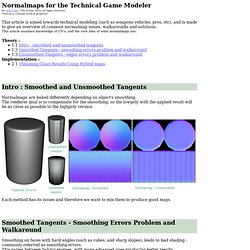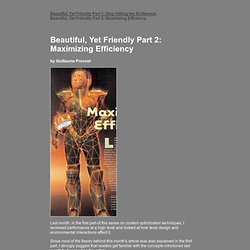

RecentChanges - Polycount Wiki. Mask Salesman Skin Sculpting Techniques Tut. Trim light. TDW144.t tips.tip8co. Constructpracticetutorial2. Blendnormals. Understanding averaged normals and ray projection/Who put waviness in my normal map? I keep seeing this question come up time and time again, what causes waviness?

How do we fix it? I feel the reason it keeps coming up, is a fundamental lack of understanding. To get to the root of the problem, we have to look at how normals are averaged, and thus, how the actual rays that are doing the "baking" are cast, and in what direction. I whipped up a quick test scene here, to show a couple different types of "waviness". More Game Art Tricks. Brief Considerations About Materials. Important: The following tutorial was written back in 2010.

A lot of it still makes sense, but some parts should (and will eventually) be revised to include the concept of PBR materials. Brief Considerations About Materials I originally made this tutorial for a lecture I gave at CCAA, a school in Brazil where I help running the Post-Graduation Course on Game Art. It came from the necessity to explain some elements of the materials that are commonly misunderstood. Especially about Specular Maps that, sometimes, seem to be a bit more obscure for most people. Most artists, in general, have a pretty good understanding of diffuse, normals, alpha, but it’s often on the specular map that they will get lost and some times even ruin a pretty good asset. I hope you enjoy it. Normalmaps for the Technical Game Modeler. Normalmaps for the Technical Game ModelerBy Ariel Chai, 15th of June 2010, all rights reserved.

*Article is constant work in progress*This article is aimed towards technical modeling (such as weapons vehicles, pros, etc), and is made to give an overview of common normalmap issues, walkarounds and solutions. This article assumes knowledge of UV's, and the core idea of what normalmaps are. Theory : Implementation :2.1 Obtaining Clean Results Using Hybrid mapsNormalmaps are baked differently depending on object's smoothing. The renderer goal is to compensate for the smoothing, so the lowpoly with the applied result will be as close as possible to the highpoly version. Each method has its issues and therefore we want to mix them to produce good maps. The theoretical walkaround to this problem, is to add more geometry to the edges - which makes them smoother, and lead to more accurate smoothing results by the realtime renderer. NormalMap. What is a Normal Map?

A Normal Map is usually used to fake high-res geometry detail when it's mapped onto a low-res mesh. The pixels of the normal map each store a normal, a vector that describes the surface slope of the original high-res mesh at that point. The red, green, and blue channels of the normal map are used to control the direction of each pixel's normal. When a normal map is applied to a low-poly mesh, the texture pixels control the direction each of the pixels on the low-poly mesh will be facing in 3D space, creating the illusion of more surface detail or better curvature. However, the silhouette of the model doesn't change. Tangent-Space vs. Normal maps can be made in either of two basic flavors: tangent-space or object-space. Tangent-space normal map Predominantly-blue colors. Maps can be reused easily, like on differently-shaped meshes. Maps can be tiled and mirrored easily, though some games might not support mirroring very well.
Easier to overlay painted details. Ysalex Anatomy Practice Thread - Page 9. So here is the first part of the tutorial I said I'd try to work up.

I'm not really a tutorial person but I got a lot of these questions and a bunch of requests for it so here it is. I got caught in some extra heavy work, but I found the time last night/today to put this together. Please let me know if you find it useful or useless, and I will either give up or complete the two other parts. Using Decals for Destroyed Structures - Doc 3. Asset Creation Guide - CryENGINE 3 Free SDK. Beautiful, Yet Friendly Part 2: Maximizing Efficiency. Beautiful, Yet Friendly Part 1: Stop Hitting the BottleneckBeautiful, Yet Friendly Part 2: Maximizing Efficiency by Guillaume Provost Last month, in the first part of this series on content optimization techniques, I reviewed performance at a high level and looked at how level design and environmental interactions affect it.

Since most of the theory behind this month's article was also explained in the first part, I strongly suggest that readers get familiar with the concepts introduced last month before reading this article. You'll need to know when and what to optimize before you can make any use of knowing how to optimize. Last month, we saw that meshes could be transform-bound or fill-bound. I've given a more complete picture of the possibility space here through the generic hardware pipe shown in Figure 1. FIGURE 1. If you are data-bound, then the amount of data transferred might also be causing transform problems (too many vertices) and/or fill problems (too much texture data).